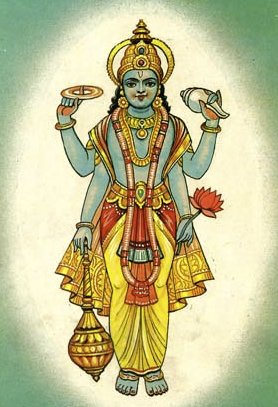Navayauvana, Navayauvanā, Nava-yauvana: 13 definitions
Introduction:
Navayauvana means something in Buddhism, Pali, Hinduism, Sanskrit, Marathi. If you want to know the exact meaning, history, etymology or English translation of this term then check out the descriptions on this page. Add your comment or reference to a book if you want to contribute to this summary article.
In Hinduism
Vaishnavism (Vaishava dharma)
Source: Pure Bhakti: Brhad BhagavatamrtamNavayauvana (नवयौवन) refers to:—Ever-fresh youth, Śrī Kṛṣṇa. (cf. Glossary page from Śrī Bṛhad-bhāgavatāmṛta).

Vaishnava (वैष्णव, vaiṣṇava) or vaishnavism (vaiṣṇavism) represents a tradition of Hinduism worshipping Vishnu as the supreme Lord. Similar to the Shaktism and Shaivism traditions, Vaishnavism also developed as an individual movement, famous for its exposition of the dashavatara (‘ten avatars of Vishnu’).
Shaivism (Shaiva philosophy)
Source: Brill: Śaivism and the Tantric TraditionsNavayauvana (नवयौवन) refers to the “prime of one’s youth”, according to the 13th-century Matsyendrasaṃhitā: a Kubjikā-Tripurā oriented Tantric Yoga text of the Ṣaḍanvayaśāmbhava tradition from South India.—Accordingly, “[Visualisation of Parameśvara]:—[...] He is in the prime of his youth (navayauvana-sampanna) and has all the auspicious characteristics. He has the great Ajagava bow placed on his left side. On his right, he has five glowing arrows. He is shining like a blue lotus. On his chest there is a glittering garland of blue lotuses. He is the Lord. [...]”.

Shaiva (शैव, śaiva) or Shaivism (śaivism) represents a tradition of Hinduism worshiping Shiva as the supreme being. Closely related to Shaktism, Shaiva literature includes a range of scriptures, including Tantras, while the root of this tradition may be traced back to the ancient Vedas.
In Buddhism
Tibetan Buddhism (Vajrayana or tantric Buddhism)
Source: OSU Press: Cakrasamvara SamadhiNavayauvana (नवयौवन) refers to a “young adolescent”, according to the Cakrasaṃvara Samādhi [i.e., Cakrasamvara Meditation] ritual often performed in combination with the Cakrasaṃvara Samādhi, which refers to the primary pūjā and sādhanā practice of Newah Mahāyāna-Vajrayāna Buddhists in Nepal.—Accordingly, “By the form of a skull cup, and by the letter Māṃ, Vāruṇī, Eighteen arms, one face, red color, and three eyes, A sword, arrow and hook, on the right, a skull cup, ax and banner, Thus a mace, thus a bell, and in the ninth, granting wishes, A two-headed drum, a bow and noose, a staff and a water pot, A trident, hammer and lute, and thus a number, in the upper hand, A young adolescent beauty (navayauvana-lāvaṇyā), a great beauty, a beautiful goddess”.

Tibetan Buddhism includes schools such as Nyingma, Kadampa, Kagyu and Gelug. Their primary canon of literature is divided in two broad categories: The Kangyur, which consists of Buddha’s words, and the Tengyur, which includes commentaries from various sources. Esotericism and tantra techniques (vajrayāna) are collected indepently.
Languages of India and abroad
Marathi-English dictionary
Source: DDSA: The Molesworth Marathi and English Dictionarynavayauvanā (नवयौवना).—f S A female just arrived at puberty; a young woman.
Source: DDSA: The Aryabhusan school dictionary, Marathi-Englishnavayauvanā (नवयौवना).—f A female just arrived at puberty, a young woman.
Marathi is an Indo-European language having over 70 million native speakers people in (predominantly) Maharashtra India. Marathi, like many other Indo-Aryan languages, evolved from early forms of Prakrit, which itself is a subset of Sanskrit, one of the most ancient languages of the world.
Sanskrit dictionary
Source: DDSA: The practical Sanskrit-English dictionaryNavayauvana (नवयौवन).—fresh youth, bloom or prime of youth.
-nā a young woman.
Derivable forms: navayauvanam (नवयौवनम्).
Navayauvana is a Sanskrit compound consisting of the terms nava and yauvana (यौवन).
Source: Cologne Digital Sanskrit Dictionaries: Shabda-Sagara Sanskrit-English DictionaryNavayauvanā (नवयौवना).—f.
(-nā) A young woman. E. nava new, and yauvana young.
Source: Cologne Digital Sanskrit Dictionaries: Cappeller Sanskrit-English DictionaryNavayauvana (नवयौवन).—1. [neuter] the first youth.
--- OR ---
Navayauvana (नवयौवन).—2. [adjective] being in the first youth.
Source: Cologne Digital Sanskrit Dictionaries: Monier-Williams Sanskrit-English Dictionary1) Navayauvaṇa (नवयौवण):—[=nava-yauvaṇa] [from nava] n. fresh youth, bloom of y°, [Bhartṛhari]
2) [v.s. ...] mf(ā)n. ([Śṛṅgāra-tilaka]) = -vat ([Monier-Williams’ Sanskrit-English Dictionary]) mfn. blooming with the freshness of y°.
Source: Cologne Digital Sanskrit Dictionaries: Yates Sanskrit-English DictionaryNavayauvanā (नवयौवना):—[nava-yauvanā] (nā) 1. f. A young woman.
[Sanskrit to German]
Sanskrit, also spelled संस्कृतम् (saṃskṛtam), is an ancient language of India commonly seen as the grandmother of the Indo-European language family (even English!). Closely allied with Prakrit and Pali, Sanskrit is more exhaustive in both grammar and terms and has the most extensive collection of literature in the world, greatly surpassing its sister-languages Greek and Latin.
Kannada-English dictionary
Source: Alar: Kannada-English corpusNavayauvana (ನವಯೌವನ):—
1) [noun] the early state of youth, characterised by immaturity, impetuosity, vigour, etc.
2) [noun] a boy in this stage.
Kannada is a Dravidian language (as opposed to the Indo-European language family) mainly spoken in the southwestern region of India.
See also (Relevant definitions)
Partial matches: Yauvana, Nava.
Ends with: Abhinavayauvana.
Full-text: Abhinavayauvana, Navatarunya, Navataruna, Navayavvana, Navayuvaka, Yauvana, Upayama, Lavanya, Udaya, Bhara.
Relevant text
Search found 6 books and stories containing Navayauvana, Navayauvanā, Nava-yauvana, Navayauvaṇa, Nava-yauvaṇa, Nava-yauvanā; (plurals include: Navayauvanas, Navayauvanās, yauvanas, Navayauvaṇas, yauvaṇas, yauvanās). You can also click to the full overview containing English textual excerpts. Below are direct links for the most relevant articles:
Bhakti-rasamrta-sindhu (by Śrīla Rūpa Gosvāmī)
Verse 4.9.31 < [Part 9 - Incomplete Expression of Mellows (rasābhāsa)]
Verse 2.1.330 < [Part 1 - Ecstatic Excitants (vibhāva)]
Verse 4.8.58 < [Part 8 - Compatible & Incompatible Mellows (maitrī-vaira-sthiti)]
Garga Samhita (English) (by Danavir Goswami)
Verse 4.4.3 < [Chapter 4 - The Story of the Kauśalā Women]
Verse 2.15.12 < [Chapter 15 - Description of Śrī Rādhā-Kṛṣṇa’s Falling in Love]
Verse 2.9.28 < [Chapter 9 - Brahmā’s Prayers]
Brihad Bhagavatamrita (commentary) (by Śrī Śrīmad Bhaktivedānta Nārāyana Gosvāmī Mahārāja)
Verse 2.4.64-65 < [Chapter 4 - Vaikuṇṭha (the spiritual world)]
Dramaturgy in the Venisamhara (by Debi Prasad Namasudra)
Śṛṅgāra or Ādya-rasa (The Erotic Sentiment) < [Chapter 4 - Dramaturgy in Veṇīsaṃhāra]
The Padma Purana (by N.A. Deshpande)
Chapter 77 - A Description of Kṛṣṇa < [Section 5 - Pātāla-Khaṇḍa (Section on the Nether World)]
Charaka Samhita and Sushruta Samhita (by Nayana Sharma)
Gender in the Saṃhitās < [Chapter 5]